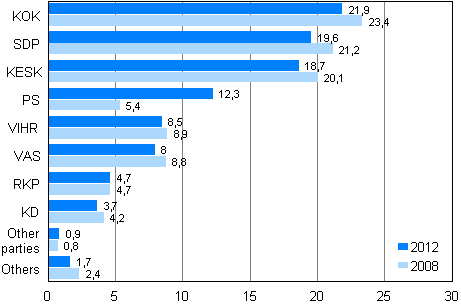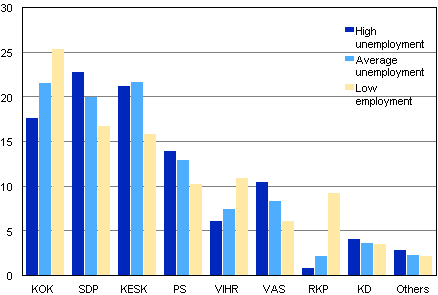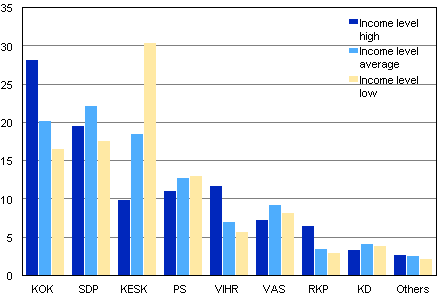Published: 2 November 2012
Confirmed result: Coalition Party retained its position as the largest political party, True Finns the biggest winners in Municipal elections 2012
Corrected on 19 March 2014. The corrected numbers
are indicated in red. Several complaints on Municipal elections
2012 have been filed to administrative courts and the results of
the elections have been changed by the decisions of administrative
courts (errors in source data have also been corrected).
The Coalition Party retained its position as the biggest political
party in the country which it had assumed in the previous Municipal
elections. The Coalition Party took 21.9 per cent of all
votes but lost its share of votes cast by 1.6 per cent
compared with the previous Municipal elections. The total number of
votes cast for the Coalition Party was 545,890, which was 51,837 votes less than in the 2008 Municipal
elections. The data are based on Statistics Finland's statistics on
the Municipal elections 2012.
Support for parties in Municipal elections 2012 and 2008, %

Other parties in 2012: Communist Party of Finland (SKP), Pirate Party (Pirate Pty), Independence Party (IP), Communist Worker's Party (KTP), Change 2011, Finnish Labour Party (STP), For the Poor (KA), Liberty Party (Liberty Pty)
Other parties in 2008: Communist Party of Finland (SKP), Independence Party (IP), Communist Worker's Party (KTP), Finnish Labour Party (STP), Finnish Seniors' Party (SSP), For the Poor (KA)
Others in 2012 and 2008: Constituency associations
The Social Democratic Party gained the second most votes and retained its position as the second largest political party in Finland. It took 19.6 per cent of all votes cast and lost 1.7 percentage points of support. The total number of votes cast for the SDP was around 487,924, which was 53,263 down from the previous Municipal elections.
The Centre Party of Finland kept its position as the third biggest party in Finland. Support for the Centre Party was 18.7 per cent and it lost 1.4 percentage points of support when compared to the preceding elections. The Centre Party took a total of 465,167 votes, which was 47,053 votes less than in 2008.
The True Finns emerged as the biggest winners in the elections as they increased their support the most of all parties and became the fourth largest party. Support for the True Finns now stood at 12.3 per cent, which was 7.0 percentage points more than in the preceding Municipal elections. The 307,798 votes taken by the True Finns indicated an increase of as much as 170,301 votes from 2008.
The Green League gained 8.5 per cent of all votes, which was 0.4 percentage points lower than in the previous Municipal elections. The Left Alliance took 8.0 per cent of all votes cast and lost 0.8 percentage points of support compared with the previous Municipal elections.
Voting turnout was distinctly lower in these elections than in the preceding Municipal elections. The voting percentage in the whole country stood at 58.3, having been 61.2 in 2008. A total of 42.4 per cent of all voters cast their vote in advance in the Municipal elections 2012.
Party analysis - True Finns the election winners
According to the result analysis made by Statistics Finland, the support for the True Finns was highest in the voting districts with high unemployment (13.9%), in agricultural areas (13.4%) and manufacturing areas (13.0%). The True Finns gained the least support in the voting districts with low unemployment (10.2%), service areas (10.8%) and high income level areas (11%). Compared with the previous Municipal elections the True Finns increased their support most in agricultural and sparsely populated areas and in those with high unemployment. Their support grew the least in the voting districts with low unemployment, services and large towns.
In the analysis, the voting districts are divided into three groups of roughly equal size on the basis of industrial structure, degree of urbanisation, income level and unemployment. Therefore, a manufacturing area refers to an area whose inhabitants work in manufacturing more than average. However, manufacturing is not necessarily the principal industry in the area. (See methodological description.)
Party support in different unemployment areas in Municipal elections 2012, %

The support for the True Finns was lowest in the districts where the Swedish People's Party conventionally receive the most support. In districts, where the support has usually been higher than average for the Social Democratic Party (SDP) and the Centre Party, the support for the True Finns was also higher.
The support for the SDP was highest in manufacturing areas (25.3%) and lowest in agricultural areas (15.1%). The SDP received the biggest losses in agricultural and sparsely populated areas and in areas of high unemployment. The support for the Coalition Party and the Green League was higher in voting districts where the income level is high, unemployment low and the share of pensioners small. The Left Alliance received most support (10.5%) in high unemployment areas despite losing its support most in these areas when compared with the Parliamentary elections.
Party support by income level in Municipal elections 2012, %

The support for the Centre Party was clearly highest of all parties in voting districts of low income level, 30.3 per cent, while in high income areas its support remained at 9.8 per cent. This difference in support is explained by high support for the Centre Party in sparsely populated areas (35.2%) and agricultural areas (38.0%), where income level is lower than average for the whole country, and lower support in towns (7.1%) and in service areas (11.6%), where income level is usually higher.
The result analysis is based on an analysis by voting district and it is available as a table in Statistics Finland's PX-Web database service. The districts, whose borders have not changed since the previous elections, were chosen as the basic data set. It is, therefore, not possible to calculate the election result by summing up the percentages.
Statistics Finland's election result services
In connection with the confirmed election result, Statistics Finland releases a review on the background of Municipal election candidates and elected councillors analysing the candidates' sex distribution, age, origin, education, employment, income level and family status in comparison to persons entitled to vote.
Statistics Finland's free of charge election map service on the web contains data illustrated by maps and charts on the Municipal election. The themes include voting turnout, the party with the most votes and support for parties and change in the support and the proportion of young, female and new councillors. The data can be browsed by various area categories such as municipalities, constituencies and the largest towns by voting district.
More detailed election result data are available in Statistics Finland's PX-Web database service where users can compile customised statistical tables on the elections.
Source: Municipal Elections 2012, confirmed result and background analysis of candidates and elected representatives, Statistics Finland
Inquiries: Kimmo Moisio 09 1734 3239, Jaana Asikainen 09 1734 3506, Kaija Ruotsalainen 09 1734 3599, Miina Keski-Petäjä 09 1734 3240, vaalit@stat.fi
Director in charge: Jari Tarkoma
Publication in pdf-format (725.2 kB)
- Reviews
- Tables
-
Tables in databases
Pick the data you need into tables, view the data as graphs, or download the data for your use.
- Quality descriptions
-
- Municipal elections, quality description (2.11.2012)
Updated 2.11.2012
Official Statistics of Finland (OSF):
Municipal elections [e-publication].
ISSN=2323-1114. 2012. Helsinki: Statistics Finland [referred: 7.1.2026].
Access method: http://stat.fi/til/kvaa/2012/kvaa_2012_2012-11-02_tie_001_en.html

